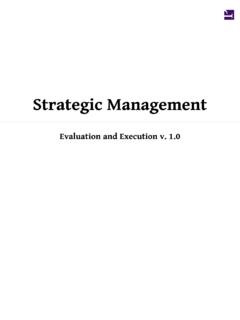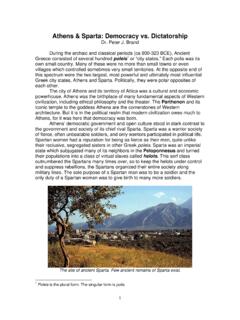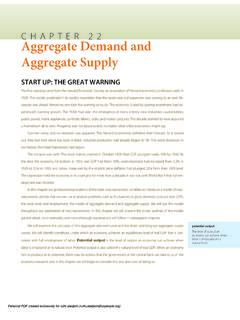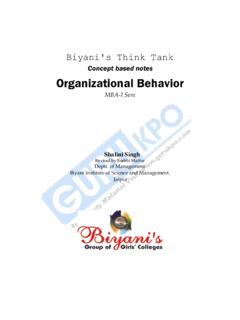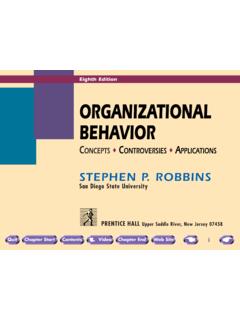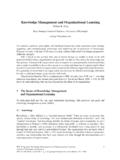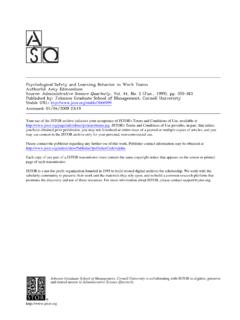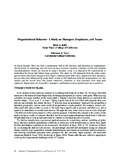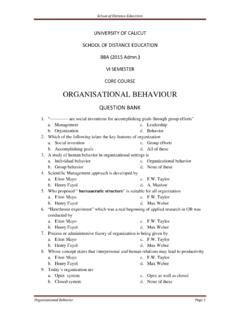Transcription of Organizational Behavior - University of the People
1 Organizational BehaviorByTalya Bauer and Berrin ErdoganFor additional learning supplements created just forthis textbook, visit access to:QuizzesFlash CardsAudio Study GuidesAtlas BlackYou ll get FREE Chapter 1 digital supplements when you register nd your class get started!fwk-28776 Organizational BehaviorTalya Bauer and Berrin ErdoganPublished by:Flat World Knowledge, Inc. One Bridge StreetIrvington, NY 10533 This work is licensed under theCreative Commons Attribution-Noncommercial-Share Alike Unported view a copy of this license, visit send a letter toCreative Commons, 171 Second Street, Suite 300, San Francisco, California, 94105, in the United States of AmericaChapter 1 Chapter 2 Chapter 3 Chapter 4 Chapter 5 Chapter 6 Chapter 7 Chapter 8 Chapter 9 Chapter 10 Chapter 11 Chapter 12 Chapter 13 Chapter 14 Chapter 15 Brief ContentsAbout the AuthorsAcknowledgmentsDedicationsPreface Organizational BehaviorManaging Demographic and Cultural DiversityUnderstanding People at Work.
2 Individual Differences and PerceptionIndividual Attitudes and BehaviorsTheories of MotivationDesigning a Motivating Work EnvironmentManaging Stress and EmotionsCommunicationManaging Groups and TeamsConflict and NegotiationsMaking DecisionsLeading People Within OrganizationsPower and PoliticsOrganizational Structure and ChangeOrganizational CultureIndex12347 Chapter 1813151722222325 Chapter 227384445464749 Chapter 35052606668697073 Chapter 4747884858687 ContentsAbout the AuthorsAcknowledgmentsDedicationsPreface Organizational BehaviorUnderstanding Organizational BehaviorUnderstanding Your Learning StyleUnderstanding How OB Research Is DoneTrends and ChangesConclusionExercisesEndnotesManagi ng Demographic and Cultural DiversityDemographic DiversityCultural DiversityThe Role of Ethics and National CultureConclusionExercisesEndnotesUnders tanding People at Work: Individual Differences and PerceptionThe Interactionist Perspective: The Role of FitIndividual Differences.
3 Values and PersonalityPerceptionThe Role of Ethics and National CultureConclusionExercisesEndnotesIndivi dual Attitudes and BehaviorsWork AttitudesWork BehaviorsThe Role of Ethics and National CultureConclusionExercisesEndnotes89 Chapter 59196105107107109111 Chapter 6112118122126129131131133135 Chapter 7136143149151155156156159161 Chapter 8162165172182185186188189 Chapter 9190197204207209210 Theories of MotivationNeed-Based Theories of MotivationProcess-Based TheoriesThe Role of Ethics and National CultureConclusionExercisesEndnotesDesign ing a Motivating Work EnvironmentMotivating Employees Through Job DesignMotivating Employees Through Goal SettingMotivating Employees Through Performance AppraisalsMotivating Employees Through Performance IncentivesThe Role of Ethics and National CultureConclusionExercisesEndnotesManagi ng Stress and EmotionsWhat Is Stress?
4 Avoiding and Managing StressWhat Are Emotions?Emotions at WorkThe Role of Ethics and National CultureConclusionExercisesEndnotesCommun icationUnderstanding CommunicationCommunication BarriersDifferent Types of Communication and ChannelsThe Role of Ethics and National CultureConclusionExercisesEndnotesManagi ng Groups and TeamsGroup DynamicsUnderstanding Team Design CharacteristicsManagement of TeamsBarriers to Effective TeamsThe Role of Ethics and National CultureConclusion211213215 Chapter 10216220223227235236237239241 Chapter 11242250253258259260263265 Chapter 12267271274280288290290292295 Chapter 13296300308311313314315319321 Chapter 14323329339
5 ExercisesEndnotesConflict and NegotiationsUnderstanding ConflictCauses and Outcomes of ConflictConflict ManagementNegotiationsThe Role of Ethics and National CultureConclusionExercisesEndnotesMaking DecisionsUnderstanding Decision MakingFaulty Decision MakingDecision Making in GroupsThe Role of Ethics and National CultureConclusionExercisesEndnotesLeadin g People Within OrganizationsWho Is a Leader? Trait Approaches to LeadershipWhat Do Leaders Do? Behavioral Approaches to LeadershipWhat Is the Role of the Context? Contingency Approaches to LeadershipWhat s New? Contemporary Approaches to LeadershipThe Role of Ethics and National CultureConclusionExercisesEndnotesPower and PoliticsThe Basics of PowerThe Power to InfluenceOrganizational PoliticsUnderstanding Social NetworksThe Role of Ethics and National CultureConclusionExercisesEndnotesOrgani zational Structure and ChangeOrganizational StructureOrganizational ChangeThe Role of Ethics and National Culture341341342343 Chapter 15344347352361364365365369371 ConclusionExercisesEndnotesOrganizationa l CultureUnderstanding Organizational CultureCharacteristics of Organizational CultureCreating and Maintaining Organizational
6 CultureCreating Culture ChangeThe Role of Ethics and National CultureConclusionExercisesEndnotesIndexA bout the AuthorsTALYA BAUERT alya Bauer ( , 1994, Purdue University ) is the Gerry and Marilyn Cameron Pro-fessor of Management at Portland State University . Dr. Bauer is an award-winningteacher who specializes in teaching Organizational Behavior , management, power andinfluence, and negotiations, as well as training and development at the graduate andundergraduate level. She conducts research about relationships at work. More specific-ally, she works in the areas of leadership, selection, and new employee onboarding,which has resulted in dozens of journal publications.
7 She has acted as a consultant for avariety of government, Fortune 1000, and start-up organizations. Dr. Bauer is involvedin professional organizations and conferences at the national level, such as serving onthe Human Resource Management Executive Committee of the Academy of Manage-ment and SIOP Program Chair and member-at-large for SIOP. She is the editor ofJournal of Managementand is on the editorial boards for theJournal of Applied Psycho-logyandIndustrial and Organizational Psychology: Perspectives on Science andPractices, was recognized as one of the most published authors of the 1990s, and is aFellow of SIOP and ERDOGANB errin Erdogan ( , 2002, University of Illinois at Chicago) is the Express Employ-ment Professionals Endowed Professor at Portland State University .
8 Dr. Erdogan is anaward-winning teacher who teaches management, Organizational Behavior , and humanresources management. Her research interests focus on individual attachment to or-ganizations through fairness, leader-subordinate relations, contextual factors such asorganizational culture, and person-organization fit. Her work has been published injournals such asAcademy of Management Journal,Journal of Applied Psychology, andPersonnel Psychology. She has conducted managerial seminars on the topics of motiva-tion, Organizational justice, performance appraisals, and training and development, andhas worked as a corporate trainer.
9 She serves on the editorial boards ofJournal of Ap-plied Psychology,Journal of Management,Journal of Organizational Behavior , andPer-sonnel want to thank Margaret Lannamann and Brett Guidry for doing such a great job keeping all the balls in the air, and Jeff Shelstadand Eric Frank for having the vision and persistence to bring Flat World Knowledge into being, and their faith in us as among thefirst Flat World Knowledge authors. Many thanks to Andrea Meyer, Sharon Koch, Pamela Tierney, Dean Scott Dawson, and Port-land State University for supporting our would also like to thank the following colleagues whose comprehensive feedback and suggestions for improving the materi-al helped make this a better text.
10 Cheryl Adkins, Longwood UniversitySid Barsuk, Governors State UniversityCarrie Blair, College of CharlestonPamela Buckle Henning, Adelphi UniversityClaudia Cogliser, Texas TechLeslie Connell, University of Central FloridaDonald Dahlin, The University of South DakotaDeborah Good, University of PittsburghGideon Falk, Purdue University , CalumetDavid Futrell, Butler UniversityBruce Gillies, California Lutheran UniversityMichael Hadani, Long Island University , CW Post CampusJeff Haldeman, Webster UniversityKathy Harris, Northwestern Oklahoma State UniversityKelly Kilcrease, University of New Hampshire, ManchesterAntoinette S.

